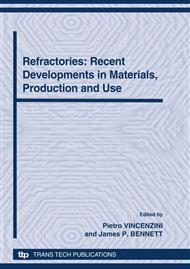p.30
p.37
p.47
p.53
p.59
p.65
p.72
p.82
p.91
Thermal Shock Behavior of Zircon Based Refractories
Abstract:
In service refractory materials are submitted to local temperature gradients that originate thermal stresses causing a thermal shock (TS) damage to the material. Practical tests for evaluating the thermal shock resistance (TSR) determine the variation or change of some characteristic property of the test sample like E (elastic module) or the strength before and after quenching. In this work, the microstructure and thermal shock behavior of Zircon based refractories are analyzed. Several compositions (eight), from pure Zircon to 70 % of Zircon were studied. The main structural and mechanical properties of the refractories were characterized, as modulus of rupture, elastic modulus, porosity, and microstructure. The dynamic elastic modulus E of the refractories was measured by the excitation technique. The TS behavior was evaluated by measuring the decrease in E and the modulus of rupture, before and after a quenching test. The influence of the presence of other phases was also analyzed. Refractories showed Zircon as the main crystalline phase. In some materials, m-ZrO2 appears coming from Zircon dissociation. The thermal shock behavior of refractory of high Zircon content is typical of the brittle ceramic materials. Materials showed a relation between elastic module and strength. Dynamic elastic modulus measurements have shown to be suitable for evaluation the TSR for these materials.
Info:
Periodical:
Pages:
59-64
Citation:
Online since:
October 2010
Keywords:
Price:
Сopyright:
© 2010 Trans Tech Publications Ltd. All Rights Reserved
Share:
Citation:


